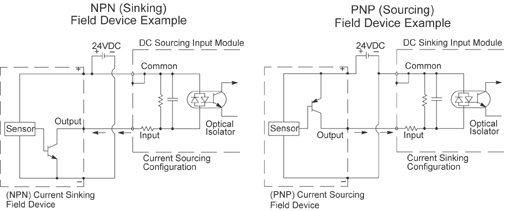When connecting a 3-wire field device to your PLC system, it is important to have a solid understanding of sinking (NPN) and sourcing (PNP) concepts.
Sinking and Sourcing
First, sinking and sourcing are only associated with DC circuits. DC circuits can conduct current in one direction only. This means that it is possible to connect the external supply and field device to an I/O point with current trying to flow in the wrong direction. By understanding sinking and sourcing concepts, the supply and field devices can be connected correctly every time.
Be sure to pay close attention to what field device you are using. If a field device is a sinking (NPN) device, then the I/O module must have a sourcing input. There are some I/O modules that are sink/source I/O circuits. This means that the circuitry will allow current to flow in either direction. When using a sink/source I/O module, you should wire all I/O points with a shared common as only sinking or only sourcing.
In the figures shown below, you will notice that the sinking PLC input module is connected so the input provides a path to supply common (-). So, starting at the PLC input terminal, follow through the input sensing circuit, exit at the common terminal, and connect the supply (-) to the common terminal. By adding the switch between the supply source (+) and the PLC input, the circuit is completed. Current flows in the direction of the arrow when the switch is closed.
NOTE:
Sinking provides a path to supply common (-).
Sourcing supplies a path to supply source (+).
[two_columns ] Sinking PLC Input Module
 [/two_columns] [two_columns_last ] Sourcing PLC Input Module
[/two_columns] [two_columns_last ] Sourcing PLC Input Module
Three-wire devices work in the same manner. The difference is that the 3-wire device has a supply source (+), supply common (-) and signal (output). In the diagrams below, for a PNP (sourcing) field device, the supply common (-) is connected to the field device common (-). The supply source (+) passes through the field device output into the PLC input (sinking), through the input sensing circuit, out the common terminal and to the supply common (-).
By following these guidelines, you should have a working circuit every time.
Field device examples – 3 wire connections
by Keri Schieber,
Managing Editor
Originally Published: April 1, 2004



